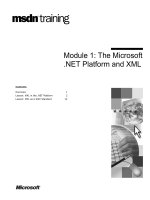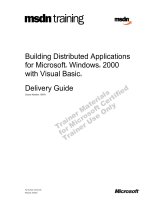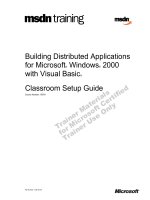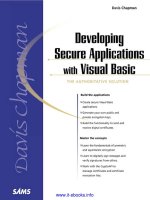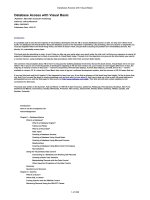Programming the Microsoft® .NET Framework with Visual Basic® .NET (Prerelease)
Bạn đang xem bản rút gọn của tài liệu. Xem và tải ngay bản đầy đủ của tài liệu tại đây (11.45 MB, 560 trang )
Course Number: 2415A
Released: 10/2001
Delivery Guide
Programming the Microsoft
®
.NET Framework with
Visual Basic
®
.NET (Prerelease)
Part Number: X08-54449
This course is based on the prerelease Beta 2 version of Microsoft
®
Visual Studio .NET.
Content in the final release of the course may be different from the content included in this
prerelease version. All labs in the course are to be completed with the Beta 2 version of
Visual Studio .NET.
Information in this document, including URL and other Internet Web site references, is subject to
change without notice. Unless otherwise noted, the example companies, organizations, products,
domain names, e-mail addresses, logos, people, places and events depicted herein are fictitious,
and no association with any real company, organization, product, domain name, e-mail address,
logo, person, place or event is intended or should be inferred. Complying with all applicable
copyright laws is the responsibility of the user. Without limiting the rights under copyright, no
part of this document may be reproduced, stored in or introduced into a retrieval system, or
transmitted in any form or by any means (electronic, mechanical, photocopying, recording, or
otherwise), or for any purpose, without the express written permission of Microsoft Corporation.
Microsoft may have patents, patent applications, trademarks, copyrights, or other intellectual
property rights covering subject matter in this document. Except as expressly provided in any
written license agreement from Microsoft, the furnishing of this document does not give you any
license to these patents, trademarks, copyrights, or other intellectual property.
2001 Microsoft Corporation. All rights reserved.
Microsoft, MS-DOS, Windows, Windows NT, ActiveX, IntelliMirror, JScript, MSDN,
PowerPoint, Visual Basic, Visual C++, Visual C#, Visual Studio, Win32, and Windows Media are
either registered trademarks or trademarks of Microsoft Corporation in the U.S.A. and/or other
countries.
The names of actual companies and products mentioned herein may be the trademarks of their
respective owners.
Course Number: 2415A
Part Number: X08-54449
Released: 10/2001
Programming the Microsoft® .NET Framework with Visual Basic® .NET (Prerelease) iii
Contents
Introduction
Course Materials ......................................................................................................2
Prerequisites.............................................................................................................3
Course Outline .........................................................................................................4
Microsoft Certified Professional Program ...............................................................8
Facilities.................................................................................................................10
Module 1: Overview of the Microsoft .NET Framework
Overview..................................................................................................................1
Overview of the Microsoft .NET Framework..........................................................2
Overview of Namespaces ......................................................................................12
Review ...................................................................................................................15
Module 2: Introduction to a Managed Execution Environment
Overview..................................................................................................................1
Writing a .NET Application.....................................................................................2
Compiling and Running a .NET Application...........................................................9
Multimedia: Application Loading and Single-File Assembly Execution ..............25
Lab 2: Building a Simple .NET Application..........................................................27
Review ...................................................................................................................30
Module 3: Working with Components
Overview..................................................................................................................1
An Introduction to Key .NET Framework Development Technologies ..................2
Creating a Simple .NET Framework Component....................................................4
Lab 3.1: Creating a .NET Framework Component................................................11
Creating a Simple Console Client..........................................................................13
Lab 3.2: Creating a Simple Console-Based Client.................................................18
Demonstration: Creating a Windows Forms Client ...............................................21
Creating an ASP .NET Client ................................................................................25
Multimedia: ASP .NET Execution Model .............................................................26
Lab 3.3: Calling a Component Through an ASP .NET Page.................................34
Review ...................................................................................................................38
Module 4: Deployment and Versioning
Overview..................................................................................................................1
Introduction to Application Deployment .................................................................2
Application Deployment Scenarios .........................................................................7
Related Topics and Tools.......................................................................................31
Lab 4: Packaging and Deployment ........................................................................37
Review ...................................................................................................................42
Module 5: Common Type System
Overview..................................................................................................................1
An Introduction to the Common Type System ........................................................2
Elements of the Common Type System...................................................................8
Object-Oriented Characteristics.............................................................................24
Lab 5: Building Simple Types ...............................................................................39
Review ...................................................................................................................44
iv Programming the Microsoft® .NET Framework with Visual Basic® .NET (Prerelease)
Module 6: Working with Types
Overview................................................................................................................. 1
System.Object Class Functionality ......................................................................... 2
Specialized Constructors....................................................................................... 12
Type Operations.................................................................................................... 18
Interfaces............................................................................................................... 27
Managing External Types ..................................................................................... 34
Lab 6: Working with Types .................................................................................. 37
Review .................................................................................................................. 42
Module 7: Strings, Arrays, and Collections
Overview................................................................................................................. 1
Strings ..................................................................................................................... 2
Terminology – Collections.................................................................................... 19
.NET Framework Arrays....................................................................................... 20
.NET Framework Collections ............................................................................... 36
Lab 7: Working with Strings, Enumerators, and Collections................................ 54
Review .................................................................................................................. 60
Module 8: Delegates and Events
Overview................................................................................................................. 1
Delegates................................................................................................................. 2
Demonstration: Using Delegates............................................................................. 8
Multicast Delegates............................................................................................... 12
Demonstration: Multicast Delegates..................................................................... 19
Events.................................................................................................................... 22
When to Use Delegates, Events, and Interfaces.................................................... 30
Lab 8: Creating a Simple Chat Server................................................................... 31
Review .................................................................................................................. 41
Module 9: Memory and Resource Management
Overview................................................................................................................. 1
Memory Management Basics.................................................................................. 2
Multimedia: Simple Garbage Collection .............................................................. 10
Non-Memory Resource Management................................................................... 12
Implicit Resource Management ............................................................................ 13
Multimedia: Garbage Collection........................................................................... 18
Explicit Resource Management ............................................................................ 25
Optimizing Garbage Collection ............................................................................ 34
Lab 9: Memory and Resource Management ......................................................... 47
Review .................................................................................................................. 53
Module 10: Data Streams and Files
Overview................................................................................................................. 1
Streams.................................................................................................................... 2
Readers and Writers................................................................................................ 4
Basic File I/O .......................................................................................................... 7
Lab 10: Files ......................................................................................................... 21
Review .................................................................................................................. 26
Programming the Microsoft® .NET Framework with Visual Basic® .NET (Prerelease) v
Module 11: Internet Access
Overview..................................................................................................................1
Internet Application Scenarios.................................................................................2
The WebRequest and WebResponse Model............................................................3
Application Protocols.............................................................................................16
Handling Errors......................................................................................................24
Security ..................................................................................................................27
Lab 11: Creating a DateTime Client/Server Application.......................................35
Review ...................................................................................................................39
Customer Evaluation..............................................................................................41
Module 12: Serialization
Overview..................................................................................................................1
Serialization Scenarios.............................................................................................2
Serialization Attributes ............................................................................................4
Object Graph............................................................................................................5
Serialization Process ................................................................................................7
Serialization Example ..............................................................................................9
Deserialization Example ........................................................................................10
Custom Serialization..............................................................................................12
Custom Serialization Example...............................................................................14
Security Issues .......................................................................................................17
Lab 12: Serialization ..............................................................................................18
Review ...................................................................................................................27
Module 13: Remoting and Web Services
Overview..................................................................................................................1
Remoting..................................................................................................................2
Remoting Configuration Files................................................................................19
Lab 13.1: Building an Order-Processing Application by Using Remoted Servers 29
Web Services .........................................................................................................37
Lab 13.2: Using a Web Service .............................................................................49
Review ...................................................................................................................53
Customer Evaluation..............................................................................................55
Programming the Microsoft® .NET Framework with Visual Basic® .NET (Prerelease) vii
About This Course
This section provides you with a brief description of the course, audience,
suggested prerequisites, and course objectives.
Description
The goal of this course is to help application developers understand the
Microsoft
®
.NET Framework. In addition to offering an overview of the .NET
Framework and an introduction to key concepts and terminology, the course
provides a series of labs, which introduce and explain .NET Framework
features that are used to code, debug, tune, and deploy applications.
Audience
This course is intended for experienced, professional software developers who
work in independent software vendors or software companies or work on
corporate enterprise development teams. Most students will be Microsoft
Visual Basic
®
developers.
Student Prerequisites
This course requires that students meet the following prerequisites:
Students should be proficient in the Visual Basic programming language
and have been exposed to the Visual Basic .NET language.
Students can meet these prerequisites by taking Course 2373, Programming
with Microsoft Visual Basic .NET (Prerelease).
Course Objectives
After completing this course, the student will be able to:
List the major elements of the .NET Framework and explain how they fit
into the .NET platform.
Explain the main concepts behind the common language runtime and use
the features of the .NET Framework to create a simple application.
Create and use components in Microsoft Windows
®
Forms-based and
ASP.NET-based applications.
Use the deployment and versioning features of the .NET runtime to deploy
multiple versions of a component.
Create, use, and extend types by understanding the Common Type System
architecture.
Create classes and interfaces that are functionally efficient and appropriate
for given programming scenarios.
Use the .Net Framework class library to efficiently create and manage
strings, arrays, collections, and enumerators.
Use delegates and events to have an event sender object signal the
occurrence of an “action” to an event receiver object.
Describe and control how memory and other resources are managed in the
.NET Framework.
viii Programming the Microsoft® .NET Framework with Visual Basic® .NET (Prerelease)
Read from and write to data streams and files.
Use the basic request/response model to send and receive data over the
Internet.
Serialize and deserialize an object graph.
Create distributed applications by using Web Services and Object
Remoting.
Programming the Microsoft® .NET Framework with Visual Basic® .NET (Prerelease) ix
Course Timing
The following schedule is an estimate of the course timing. Your timing may
vary.
Day 1
Start End Module
9:00 9:30 Introduction
9:30 10:00 Module 1: Overview of the Microsoft .NET Framework
10:00 10:15 Break
10:15 11:00 Module 2: Introduction to a Managed Execution Environment
11:00 11:15 Lab 2: Building a Simple .NET Application
11:15 11:45 Module 3: Working with Components
11:45 12:00 Lab 3.1: Creating a .NET Framework Component
12:00 1:00 Lunch
1:00 1:15 Module 3: Working with Components (continued)
1:15 1:30 Lab 3.2: Creating a Simple Console-Based Client
1:30 2:00 Module 3: Working with Components (continued)
2:00 2:30 Lab 3.3: Calling a Component Through an ASP .NET Page
2:30 2:45 Break
2:45 4:15 Module 4: Deployment and Versioning
Day 2
Start End Module
9:00 9:50 Lab 4: Packaging and Deployment
9:50 10:00 Break
10:00 11:30 Module 5: Common Type System
11:30 12:30 Lunch
12:30 1:15 Lab 5: Building Simple Types
1:15 2:30 Module 6: Working with Types
2:30 2:45 Break
2:45 3:30 Lab 6: Working with Types
3:30 4:00 Module 7: Strings, Arrays, and Collections
x Programming the Microsoft® .NET Framework with Visual Basic® .NET (Prerelease)
Day 3
Start End Module
9:00 10:30 Module 7: Strings, Arrays, and Collections (continued)
10:30 10:45 Break
10:45 11:45 Lab 7: Working with Strings, Enumerators, and Collections
11:45 12:45 Lunch
12:45 2:00 Module 8: Delegates and Events
2:00 2:15 Break
2:15 3:25 Lab 8: Creating a Simple Chat Server
3:25 4:00 Module 9: Memory and Resource Management
Day 4
Start End Module
9:00 10:30 Module 9: Memory and Resource Management (continued)
10:30 10:45 Break
10:45 11:45 Lab 9: Memory and Resource Management
11:45 12:45 Lunch
12:45 1:30 Module 10: Data Streams and Files
1:30 2:15 Lab 10: Files
2:15 2:30 Break
2:30 3:30 Module 11: Internet Access
3:30 4:15 Lab 11: Creating a DateTime Client/Server Application
Day 5
Start End Module
9:00 9:30 Module 12: Serialization
9:30 10:15 Lab 12: Serialization
10:15 10:30 Break
10:30 11:30 Module 13: Remoting and Web Services
11:30 12:30 Lunch
12:30 1:20 Lab 13.1: Building an Order-Processing Application by Using
Remoted Servers
1:20 2:20 Module 13: Remoting and Web Services (continued)
2:20 2:35 Break
2:35 3:25 Lab 13.2: Using a Web Service
Programming the Microsoft® .NET Framework with Visual Basic® .NET (Prerelease) xi
Trainer Materials Compact Disc Contents
The Trainer Materials compact disc contains the following files and folders:
Autorun.exe. When the CD is inserted into the CD-ROM drive, or when you
double-click the autorun.exe file, this file opens the CD and allows you to
browse the Student Materials or Trainer Materials CD.
Default.htm. This file opens the Trainer Materials Web page.
Readme.txt. This file contains a description of the compact disc contents and
setup instructions in ASCII format (not a Microsoft Word document).
2415A_ms.doc. This file is the Manual Classroom Setup Guide. It contains a
description of classroom requirements, classroom configuration, and
classroom setup instructions.
StudentCD. This folder contains the Web page that provides students with
links to resources pertaining to this course, including additional reading,
review and lab answers, lab files, multimedia presentations, and course-
related Web sites.
Errorlog. This folder contains a template that is used to record any errors
and corrections that you find in the course.
Fonts. This folder contains fonts that are required to view the Microsoft
PowerPoint
®
presentation and Web-based materials.
Menu. This folder contains elements for Autorun.exe.
Mplayer. This folder contains files that are required to install Microsoft
Windows Media
™
Player.
Powerpnt. This folder contains the PowerPoint slides that are used in this
course.
Pptview. This folder contains the PowerPoint Viewer, which is used to
display the PowerPoint slides.
Webfiles. This folder contains the files that are required to view the course
Web page. To open the Web page, open Windows Explorer, and in the root
directory of the compact disc, double-click Default.htm or Autorun.exe.
xii Programming the Microsoft® .NET Framework with Visual Basic® .NET (Prerelease)
Student Materials Compact Disc Contents
The Student Materials compact disc contains the following files and folders:
Autorun.exe. When the CD is inserted into the CD-ROM drive, or when you
double-click the autorun.exe file, this file opens the CD and allows you to
browse the Student Materials CD.
Default.htm. This file opens the Student Materials Web page. It provides
you with resources pertaining to this course, including additional reading,
review and lab answers, lab files, multimedia presentations, and course-
related Web sites.
Readme.txt. This file contains a description of the compact disc contents and
setup instructions in ASCII format (not a Microsoft Word document).
2415A_ms.doc. This file is the Classroom Setup Guide. It contains a
description of classroom requirements, classroom setup instructions, and the
classroom configuration.
Democode. This folder contains demonstration code.
Flash. This folder contains the installer for the Macromedia Flash 5.0
browser plug-in.
Fonts. This folder contains fonts that are required to view the PowerPoint
presentation and Web-based materials.
Labs. This folder contains files that are used in the hands-on labs. These
files may be used to prepare the student computers for the hands-on labs.
Media. This folder contains files that are used in multimedia presentations
for this course.
Menu. This folder contains elements for autorun.exe.
Mplayer. This folder contains files that are required to install Microsoft
Windows Media
™
Player.
Webfiles. This folder contains the files that are required to view the course
Web page. To open the Web page, open Windows Explorer, and in the root
directory of the compact disc, double-click Default.htm or Autorun.exe.
Wordview. This folder contains the Word Viewer that is used to view any
Word document (.doc) files that are included on the compact disc.
Programming the Microsoft® .NET Framework with Visual Basic® .NET (Prerelease) xiii
Document Conventions
The following conventions are used in course materials to distinguish elements
of the text.
Convention Use
Indicates an introductory page. This symbol appears next
to a topic heading when additional information on the topic
is covered on the page or pages that follow it.
bold Represents commands, command options, and syntax that
must be typed exactly as shown. It also indicates
commands on menus and buttons, dialog box titles and
options, and icon and menu names.
italic In syntax statements or descriptive text, indicates argument
names or placeholders for variable information. Italic is
also used for introducing new terms, for book and course
titles, and for emphasis in the text.
Title Capitals Indicate domain names, user names, computer names,
directory names, and folder and file names, except when
specifically referring to case-sensitive names. Unless
otherwise indicated, you can use lowercase letters when
you type a directory name or file name in a dialog box or
at a command prompt.
ALL CAPITALS
Indicate the names of keys, key sequences, and key
combinations — for example, ALT+SPACEBAR.
monospace
Represents code samples or examples of screen text.
[ ] In syntax statements, enclose optional items. For example,
[filename] in command syntax indicates that you can
choose to type a file name with the command. Type only
the information within the brackets, not the brackets
themselves.
{ } In syntax statements, enclose required items. Type only the
information within the braces, not the braces themselves.
| In syntax statements, separates an either/or choice.
Indicates a procedure with sequential steps.
... In syntax statements, specifies that the preceding item may
be repeated.
.
.
.
Represents an omitted portion of a code sample.
THIS PAGE INTENTIONALLY LEFT BLANK
Contents
Introduction 1
Course Materials 2
Prerequisites 3
Course Outline 4
Microsoft Certified Professional Program 8
Facilities 10
Introduction
This course is based on the prerelease Beta 2 version of Microsoft® Visual Studio .NET.
Content in the final release of the course may be different from the content included in this
prerelease version. All labs in the course are to be completed with the Beta 2 version of
Visual Studio .NET.
Information in this document, including URL and other Internet Web site references, is subject to
change without notice. Unless otherwise noted, the example companies, organizations, products,
domain names, e-mail addresses, logos, people, places and events depicted herein are fictitious,
and no association with any real company, organization, product, domain name, e-mail address,
logo, person, place or event is intended or should be inferred. Complying with all applicable
copyright laws is the responsibility of the user. Without limiting the rights under copyright, no
part of this document may be reproduced, stored in or introduced into a retrieval system, or
transmitted in any form or by any means (electronic, mechanical, photocopying, recording, or
otherwise), or for any purpose, without the express written permission of Microsoft Corporation.
Microsoft may have patents, patent applications, trademarks, copyrights, or other intellectual
property rights covering subject matter in this document. Except as expressly provided in any
written license agreement from Microsoft, the furnishing of this document does not give you any
license to these patents, trademarks, copyrights, or other intellectual property.
2001 Microsoft Corporation. All rights reserved.
Microsoft, MS-DOS, Windows, Windows NT, ActiveX, IntelliMirror, JScript, MSDN,
PowerPoint, Visual Basic, Visual C++, Visual C#, Visual Studio, Win32, and Windows Media are
either registered trademarks or trademarks of Microsoft Corporation in the U.S.A. and/or other
countries.
The names of actual companies and products mentioned herein may be the trademarks of their
respective owners.
Introduction iii
Instructor Notes
The Introduction module provides students with an overview of the course
content, materials, and logistics for Course 2415A, Programming the Microsoft
.NET Framework with Visual Basic .NET (Prerelease).
Course Materials and Preparation
Required Materials
To teach this course, you need the following materials:
Delivery Guide
Trainer Materials compact disc
Presentation:
30 Minutes
iv Introduction
Module Strategy
Use the following strategy to present this module:
Course 2415A: Programming the Microsoft .NET Framework with
Visual Basic .NET (Prerelease)
Show the slide that displays the course number and course title.
Introduction
Welcome students to the course and introduce yourself. Provide a brief
overview of your background to establish credibility.
Have students introduce themselves and provide their background, product
experience, and expectations of the course.
Record student expectations on a white board or flip chart that you can
reference later in class.
Course Materials
Explain the purpose of all materials used in this course.
Prerequisites
Provide the students with the list of prerequisites that they should have met
before taking this course. This is an opportunity for you to identify students
who may not have the appropriate background or experience to attend this
course.
Course Outline
Provide an overview of each module and what students will learn.
Explain how this course will meet students’ expectations by relating the
information covered in individual modules to their expectations.
Microsoft Certified Professional Program
Inform students about the Microsoft Certified Professional (MCP) program
and the various certification options.
Facilities
Explain the facility information for the training site.
Introduction 1
Introduction
Name
Company Affiliation
Title/Function
Job Responsibility
Programming Experience
.NET Framework Experience
Expectations for the Course
*****************************
ILLEGAL FOR NON
-
TRAINER USE
******************************
Topic Objective
To introduce yourself,
establish credibility, meet
students, and set student
expectations for the course.
Lead-in
Good morning. Welcome to
Course 2415A:
Programming the Microsoft
.NET Framework with
Visual Basic .NET
(Prerelease).
My name is...
Introduce yourself.
Provide a brief overview of
your background to
establish credibility as a
.NET Framework instructor.
Ask students to introduce
themselves, addressing the
bulleted items on the slide.
Delivery Tip
As students introduce
themselves, use a white
board or flip chart to record
their expectations of the
course.
2 Introduction
Course Materials
Name Card
Student Workbook
Student Materials Compact Disc
Course Evaluation
*****************************
ILLEGAL FOR NON
-
TRAINER USE
******************************
The following materials are included with your kit:
Name card. Write your name on both sides of the name card.
Student workbook. The student workbook contains the material covered in
class, in addition to the hands-on lab exercises.
Student Materials compact disc. The Student Materials compact disc
contains the Web page that provides you with links to resources pertaining
to this course, including additional readings, review and lab answers, lab
files, multimedia presentations, and course-related Web sites.
To open the Web page, insert the Student Materials compact disc into
the CD-ROM drive, and then in the root directory of the compact disc,
double-click Autorun.exe or Default.htm.
Course evaluation. To provide feedback on the course, training facility, and
instructor, you will have the opportunity to complete an online evaluation
near the end of the course.
To provide additional comments or inquire about the Microsoft Certified
Professional program, send e-mail to
.
Topic Objective
To identify and describe the
course materials.
Lead-in
We have provided
everything you need for this
course. You will find the
following materials at your
desk...
Describe the contents of the
student workbook and the
Student Materials compact
disc.
Have students write their
names on both sides of the
name card.
Tell students where they
can send comments with
feedback on the course.
Delivery Tip
Demonstrate how to open
the Web page provided on
the Student Materials
compact disc. On the
Trainer Materials compact
disc, double-click
Autorun.exe or
Default.htm in the
StudentCD folder.
Note
Introduction 3
Prerequisites
Proficiency in the Visual Basic Language
Some Exposure to the Visual Basic .NET Language
*****************************
ILLEGAL FOR NON
-
TRAINER USE
******************************
This course requires that you meet the following prerequisites:
Proficiency in the Microsoft Visual Basic
®
programming language
Some exposure to the Visual Basic .NET language
Students can meet the prerequisites by taking Course 2373A, Programming
with Microsoft Visual Basic .NET (Prerelease).
Topic Objective
To present and describe the
prerequisites for this course.
Lead-in
The following prerequisite
knowledge is needed for this
course.
4 Introduction
Course Outline
Module 1: Overview of the Microsoft .NET Framework
Module 2: Introduction to a Managed Execution
Environment
Module 3: Working with Components
Module 4: Deployment and Versioning
Module 5: Common Type System
Module 6: Working with Types
*****************************
ILLEGAL FOR NON
-
TRAINER USE
******************************
Module 1, “Overview of the Microsoft .NET Framework,” defines terminology
specific to the Microsoft .NET Framework and describes its key features and
benefits. This module also discusses the namespaces taught in this course.
There will be minimal lecture and no lab. After completing this module, you
will be able to list the major elements of the .NET Framework.
Module 2, “Introduction to a Managed Execution Environment,” introduces the
concept of managed execution and shows developers how to quickly build
applications that take advantage of the new .NET Framework common
language runtime environment. After completing this module, you will be able
to explain the main concepts behind the common language runtime and use the
features of the .NET Framework to create a simple application.
Module 3, “Working with Components,” discusses how to create a small,
componentized application where modules can easily be written in either
Microsoft Visual Basic or C#. The steps necessary to construct, compile, and
run each program are covered in detail. This module also explains how to build
the client application by using the Windows Forms library and Microsoft
ASP .NET Web Forms. After completing this module, you will be able to create
and use components in Windows Forms-based and ASP .NET-based
applications.
Module 4, “Deployment and Versioning,” explains how to use deployment and
versioning features of the .NET Framework common language runtime to build
and deploy applications that are fully managed and protected. After completing
this module, you will be able to use the deployment and versioning features of
the .NET Framework common language runtime to deploy multiple versions of
a component.
Topic Objective
To provide an overview of
each module and what
students will learn.
Lead-in
In this course, we will
cover...
Briefly describe each
module.
As you describe each
module, acknowledge any
information that will meet
the student expectations
that you recorded earlier.
Introduction 5
Module 5, “Common Type System,” introduces the Common Type System.
The module discusses how to differentiate between value types and reference
types and examines how classes, interfaces, properties, methods, events, and
values are represented in the .NET Framework. After completing this module,
you will be able to create, use, and extend types by understanding the Common
Type System architecture.
Module 6, “Working with Types,” discusses the use of attributes to control
visibility and inheritance on types and explains how to work with various type
operations, such as boxing and unboxing, and type operators. In addition, this
module discusses how to build an interface that supports methods and
properties and how to make interface designs more efficient. Finally, this
module highlights features that are designed to help you work with unmanaged
types, such as Component Object Model (COM) types. After completing this
module, you will be able to create classes and interfaces that are functionally
efficient and appropriate for given programming scenarios.
6 Introduction
Course Outline (continued)
Module 7: Strings, Arrays, and Collections
Module 8: Delegates and Events
Module 9: Memory and Resource Management
Module 10: Data Streams and Files
Module 11: Internet Access
Module 12: Serialization
Module 13: Remoting and Web Services
*****************************
ILLEGAL FOR NON
-
TRAINER USE
******************************
Module 7, “Strings, Arrays, and Collections,” describes some of the key classes
in the .NET Framework class library. This module explains how to work with
strings, arrays, collections, and enumerators. After completing this module, you
will be able to use the .NET framework class library to efficiently create and
manage strings, arrays, collections, and enumerators.
Module 8, “Delegates and Events,” explains how the .NET Framework uses
delegates in callback and event-handling scenarios. After completing this
module, you will be able to use delegates and events to have an event sender
object signal the occurrence of an “action” to an event receiver object.
Module 9, “Memory and Resource Management,” discusses how the .NET
Framework automatically handles the allocation and release of an object’s
memory resources through garbage collection. After completing this module,
you will be able to describe and control how memory and other resources are
managed in the .NET Framework.
Module 10, “Data Streams and Files,” introduces the System.IO namespace
and discusses the types that it contains that allow synchronous and
asynchronous reading from and writing to data streams and files. This module
discusses synchronous operations only, as asynchronous operations are beyond
the scope of this course. After completing this module, you will be able to read
from and write to data streams and files.
Module 11, “Internet Access,” discusses the use of the System.Net classes to
communicate with other applications by using common protocols, such as
HTTP, Transmission Control Protocol (TCP), User Datagram Protocol (UDP),
and Socket Internet protocols. After completing this module, you will be able to
use the basic request/response model to send and receive data over the Internet.
Introduction 7
Module 12, “Serialization,” explains how to use serialization to convert a graph
of objects into a linear sequence of bytes, which can then be sent to a remote
computer and deserialized, thereby making a clone in the remote memory of the
original graph of objects. After completing this module, you will be able to
serialize and deserialize an object graph.
Module 13, “Remoting and Web Services,” explains how .NET Remoting
supports communication between objects in different application domains, in
different processes, and on different computers. The module describes how the
common language runtime remoting infrastructure provides a rich set of classes
that enable you to ignore most of the complexities of deploying and managing
remote objects. After completing this module, you will be able to create
distributed applications by means of Web Services and Object Remoting.




